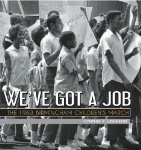Through the Looking Glass Children's Book Reviews
We've Got a Job: The 1963 Birmingham Children's March
Nonfiction
For ages 10 and up
Peachtree Publishers, 2012 ISBN: 978-1561456277
In the 1950’s and early 1960’s the city of Birmingham in Alabama was the most segregated city in the United States. Radical Segregation Ordinances, put in place in 1951, made sure that the separation between blacks and whites was total. Parks, theatres, restaurants and other public places were segregated. Blacks had to use separate drinking fountains and courtroom bibles, and they were forced to live in all back neighborhoods. Though the idea was “separate but equal” the facilities available for blacks were not as good as the ones whites used. Even when the United States Supreme Court decided that these inequalities were no longer acceptable, the city of Birmingham ignored the new laws.
Not surprisingly, people in the black community decided that something had to be done. If Birmingham would not desegregate by choice, it would have to be forced to do so. Demonstrations, sit-ins and other events were put together. The one thing that all these protests had in common was that the black participants were peaceful. Even when they were beaten and attacked by police dogs, the demonstrators did not fight back.
Audrey Faye Hendricks was the daughter of two activists. For as long as she could remember her parents had been part of the anti-segregation movement. She went to meetings and demonstrations with her parents, and she understood their cause intimately. When she was only nine years old she decided that it was not enough for her to go with her parents. She had to do something meaningful in her own right. Thus it was that on May 2, 1963, Audrey, with her parent’s support, left home with the intention of getting arrested and imprisoned.
She was not the only young person to do this. Another person was Washington Booker III. Washington had a hard childhood, and he frequently skipped school so that he could go into the woods with his friends. He had no interest in getting involved in the cause. The Birmingham police murdered several people every week. He was determined that he wasn’t going to put his life in their hands by marching, and yet when the Children’s March took place, Washington was one of the young people who walked and chanted.
James W. Stewart didn’t want to get involved either at first, but after attending some meetings and hearing speakers talking about the need for change, James decided that though he did not have “the fortitude” for sit-ins, he could march.
When she was still quite young, Arnetta Streeter’s father tried to get his children to participate in the anti-segregation movement. He wanted them to try to go to a white school and to sit in the white section of the bus, but his daughters were afraid and so he backed down. Then Arnetta heard Dr. Martin Luther King Jr. speak and she realized that Dr. King’s cause was also her cause. She had to do her part somehow.
In this extraordinary book the author tells the story of the Birmingham Children’s March, focusing on the experiences of four young people who participated. It is interesting to get to know these four very different people, who somehow found the courage to do something that was extremely dangerous. It is also interesting to see what it was that compelled them to feel that it was their “job” to demonstrate, even if it meant that they ended up in jail.
In addition to the story of the young people’s experience, the author provides readers with plenty of background information about what it was like to live in Birmingham at that time, who the key players were, how the people involved in the anti-segregation movement planned their demonstrations, and much more. Annotated period photographs fill the book, and they help readers to get a very real sense of the times being described.




